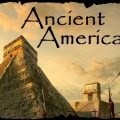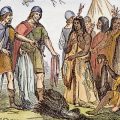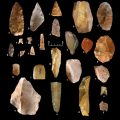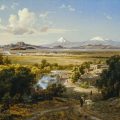
About 8,000 years ago (6000 BCE), the American Indian cultures of the Northern Plains began undergoing a series of major changes. There was a decrease in dependence on big game hunting as the people engaged in a wide range of hunting and gathering patterns. This is a period which archaeologists call the Archaic Period (also called the Middle Precontact Period by some archaeologists).
At about 5000 BCE, the Great Plains began to enter into a climate period known as the Altithermal. This was a hot, dry episode that lasts for about 2,500 years. During this time, the bison had to shift their ranges and subsequently Indian people either moved with them or changed to other game. In his Columbia University Ph.D. Dissertion on the MacHaffie Site, Richard Forbis reports:
“During the Altithermal period, climatic conditions appear to have forced bison from the Plains to the northerly regions. Man does not seem to have occupied the Plains in the Altithermal period. Man did, however, occupy other areas of North America then.”
The lack of moisture during this period meant that the production of grasses needed to sustain bison herds was restricted. Archaeologist Douglas MacDonald, in his book Montana Before History: 11,000 Years of Hunter-Gatherers in the Rockies and Plains, writes:
“Humans adapted to the changing climate and decreasing bison by increasing the breadth of their diets, changing their technology, exploiting new resources, and living in different places.”
In his book Prehistory of the Americas, archaeologist Stuart Fiedel writes:
“It seems that the bison deserted much of the Plains; some of them may have taken refuge in stream valleys or peripheral foothill areas where the water shortage was less severe.”
In his book Indians in Yellowstone National Park, anthropologist Joel Janetski writes:
“It is characterized by a greater reliance on plant foods, especially small seeds, and the increased hunting of smaller animals, although the modern large animals—deer, mountain sheep, and bison—continued to be important.”
Briefly described below are some of the Wyoming sites between 6000 BCE and 2500 BCE.
Buffalo Kill: about 6000 BCE, near Casper, Wyoming, hunters used a parabolic sand dune with steep sides to capture a herd of about 100 bison during a hunt in late autumn. The bisons’ hooves sank into the loose sand and immobilized them, which allowed the hunters to move in and kill them at close range.
James Allen: by 5900 BCE, Indian people are occupying the James Allen site (48AB4). The stone used to make the tools found at the site are from a site a hundred mile or so to the north-northeast.
48JO303: by 5850 BCE, Indian people are now occupying sit 48JO303 in the southern Big Horn Mountains. The site is located at an elevation of 7000 feet and consists of a small group of rockshelters. One of these rockshelters, designated as Shelter Three, faces west onto a steep drainage. Don Grey, in a report in the Wyoming Archaeologist, writes:
“Shelter Three had about 300 square feet of floor space under an overhanging ledge, and opened onto a large flat area thirty to forty feet wide and a hundred feet long.”
The stone projectile points in the site include McKean-like materials.
Southsider Cave: by 5700 BCE, people were occupying the Southsider Cave (48BH364). The occupants dug two cache pits about 58 centimeters in diameter and about 45 centimeters deep. The cache pits, when uncovered by archaeologists, were filled with trash. According to George Frison, in an entry in the Handbook of North American Indians:
“However, in order to preserve a cache pit of this nature for reuse once it is emptied, it must be filled with something or the sides will collapse within a short period. The easiest way to preserve them was to fill them with trash, which was removed when the pit was reused.”
Mummy Cave: by 5680, Indian people were occupying Mummy Cave (48PA201) in northwestern Wyoming.
Trappers Point: by 5580 BCE, Indian hunters camping at Trappers Point were killing pronghorn antelope and other animals. The pronghorn were corralled, killed, and then butchered. All parts of the animals are used
Chittendon Bridge: by 5000 BCE, Indian people were using the Chittendon Bridge site east of Mammoth Hot Springs on the Gardner River in present-day Yellowstone National Park.
Deadman Wash: by about 4890 BCE, Indians were occupying the Deadman Wash Site (48SW1455) in southwest Wyoming.
Helen Lookingbill: by 4800 BCE, Indian people were using the Helen Lookingbill site (48FR308) which is located at an elevation of more than 10,000 feet the Absoroka Mountains. Archaeologist Douglas MacDonald writes:
“Several bighorn sheep are represented at the site, but no bison. Local cherts were quarried at the site, suggesting a tethered settlement pattern around known resources in this rugged setting.”
Hawken: by 4340 BCE, the Hawken site (48CK303) in northeast Wyoming was used as a communal buffalo kill site. This was an arroyo trap. The bison were killed in the winter. The bison bones at the site are intermediate in size, between the extinct Bison antiquus and the modern Bison bison.
Fishing Bridge Point: By 3870 BCE, Indian people were using the Fishing Bridge Point site in present-day Yellowstone National Park. Archaeologist Douglas MacDonald writes:
“The presence of Early Archaic sites on the Yellowstone Plateau shows that Early Archaic hunter-gatherers moved into the uplands, at least during the warmer months, to hunt animals and collect the plethora of plant resources available around the shores of Yellowstone Lake.”
Twin Creek Valley: about 3260 BCE, Indian people began using a camp site in the Twin Creek Valley. Among the tools they were using were obsidian projectile points from Malad, Idaho (about 135 km to the northwest).
Hogsback: by 3330 BCE, Indian people are now occupying a pithouse at the Hogsback site (48UT2516). The pithouse is of moderate size: slightly more than 4 meters by slightly less than 4 meters. The structure was repeatedly occupied as a seasonal camp for several years. Roasting pits at the site appear to be used for cooking meat. Archaeologist Summer Moore, reporting in the Wyoming Archaeologist, writes:
“Analysis of faunal remains from the site indicates animal use was primarily focused on the procurement and processing of large game animals such as pronghorn, although the significant proportion of rabbit-sized faunal remains also suggests small animals were captured, as well. Pronghorn antelope appear to have been transported to the site as whole carcasses, possibly suggesting a trapping location or otherwise advantageous hunting site was situated nearby.”
The site was occupied during the period which archaeologists call the Opal Phase in the Wyoming Basin. This phase is characterized by a decrease in mobility due to the availability of large game animals.
House Structure: by 3250 BCE, Indian people at site 48CO1712 in the Powder River Basin constructed a house. The people at this site were gathering wild plants, such as goosefoot, and hunting mule deer and pronghorns.
McKean: by 2590 BCE, Indian people were occupying the McKean site (48CK7) near the Belle Fouche River in northeastern Wyoming. They were hunting bison as well as deer, rabbit, and pronghorn.
Scoggin: about 2540 BCE, a small band of Indian hunters used the Scoggin site (48CR304) as a bison impoundment area. The impounded buffalo were killed by using a thrusting spear. This site is located in south central Wyoming near the North Platte River.
Dead Indian Creek: by 2500 BCE, Indian people were hunting deer between October and March near the Dead Indian Creek site (48PA551) in northwestern Wyoming. This suggests that this high elevation site was occupied during the winter. Features at the site suggest that the Indian people here had constructed a housepit. Anthropologists Peter Nabokov and Lawrence Loendorf, in their book Restoring a Presence: American Indians and Yellowstone National Park, report:
“They ate mule deer, elk, and bighorn sheep, processed collected seeds, possibly making flour to thicken soup or to bake a mealy, unleavened bread, and survived at elevations where winter temperatures can drop to life-threatening lows.”
Mule deer skull caps at the Dead Indian site were arranged with their antlers attached which suggests ceremonial treatment. While sheep were an important source of food, there is no evidence of ceremonial treatment for these animals.
Medithermal Period: about 2500 BCE, the Medithermal period began with temperatures declining to modern levels. With regard to the Plains area, Richard Forbis reports:
“The Medithermal marked a return of cooler temperatures. Probably its effect on the Plains was a reduction in the number, intensity, and duration of drought periods and a gradual westward and southward return of the grasslands. And with the grasslands, capable of supporting year-round grazing, bison reappeared in great numbers; man followed the buffalo. All bison of the Medithermal period appear to be modern species.”
Note: the information in parenthesis following the name of the site is the Smithsonian Designation System. In this system of recording archaeological sites, the first number refers to the state; this is followed by letters which refer to the county; and then a number indicating its order in being recorded. Thus 5LP 10, means that the site is in Colorado (5th state when the states are listed alphabetically), La Plata County (LP), and was the 10th site recorded in La Plata county in the State Archaeologist’s office.




Leave a Reply